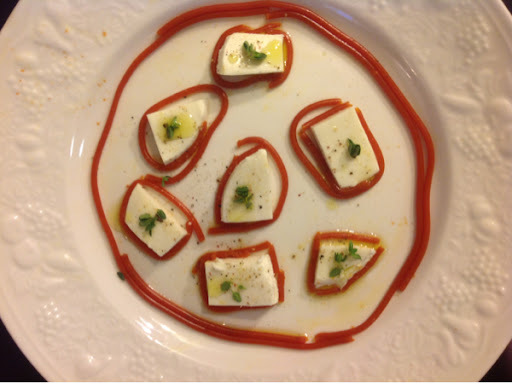It’s every kid’s favorite food. Why can’t it be every adult’s? With the use of agar, noodles don’t need to be the boring pasta we grew up with. Instead of just flour, noodles can be made with almost any conceivable food. Favorite food mushrooms? Spinach? Peas? Throw out the flour and grab a handful of your favorite food and some agar.

As demonstrated previously, tomatoes have been my favorite food. Therefore, I decided to start my experimentation with them. I liked the idea of taking traditional pasta and tomato sauce and cutting out the middle man.
To make tomato spaghetti, you need a couple items that most kitchens aren’t equipped with, a syringe and tight fitting PVC tubes.

The first step is to create a soup of what you want to make the pasta out of. Make it just as flavorful as you would make soup, and salt it slightly more than you normally would. I made tomato soup from fresh tomatoes, tomato paste, chicken broth, and a number of spices. I let it stay on medium heat for ~30 minutes. When it was ready to be served as soup, it was done.

The next step is to strain it. I discarded the chunky parts that were left in the strainer, so that only a fine tomato liquid was left. Then I measured 5.5 Oz (~150 g) of the filtered tomato soup. I placed in in a pan with 2.5 g of Agar. This was heated up to boiling and mixed thoroughly for 5-10 minutes.

When I was sure the agar was dissolved and uniformly distributed, I turned off the heat but allowed the pan to sit on the burner. If you remember from “Balsamic Vinegar Caviar” agar relaxes at higher temperatures, and begins to solidify and form a matrix at lower temperatures. This chemical process is what we are taking advantage of.

We begin by filling up the syringe with the hot tomato/agar soup. In this stage, the agar is relaxed and incorporated uniformly throughout the tomato soup. It should be a smooth liquid. The syringe is then attached to the end of a PVC tube. The PVC tubes can be curled around the fist for easier handling if desired.

When the entire PVC tube is filled with the hot tomato/agar soup, it is submerged in cold water. It is allowed to sit submerged for ~5 minutes or less, until it sets. This is the point where the agar is solidifying. Remember that at decreased temperatures, the agar forms double helix strands that then bind to other agar double helix strands, forming a matrix and trapping the other materials. This is how the tomato agar spaghetti is formed. What once was a hot tomato/agar soup has now become a cold matrix that have formed in the shape of the container they were in when the agar solidified, otherwise known as our tomato agar spaghetti.

The last step is the hardest. Now that we have formed our spaghetti, we need to get them out of the tubes. The best way to do this is to fill up the syringe with either air or cold water, and push the spaghetti out of the tube. Be careful not to push too quickly, or the noodles may break.
And that’s it. Spaghetti made fun by the science of agar!

Resources:
http://www.molecularrecipes.com/gelification/tomato-agar-spaghetti/
http://www.molecularrecipes.com/gelification/agar-agar-spaghetti/
Leave a Reply